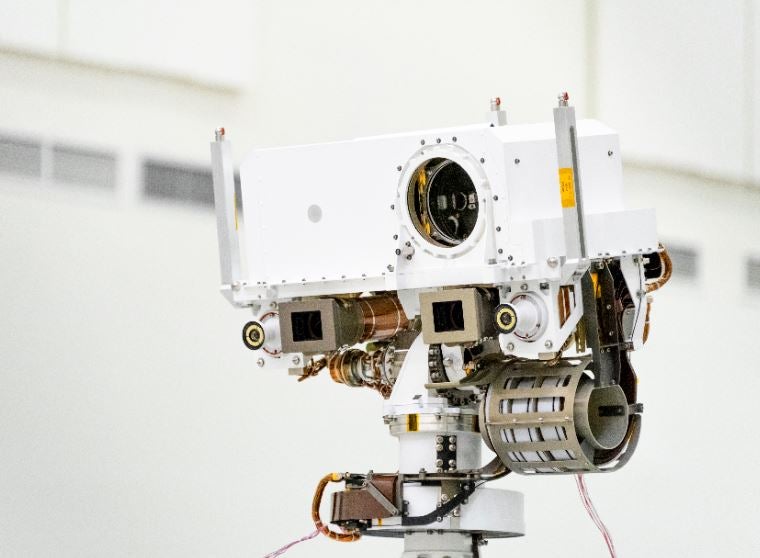Join ASU Mastcam-Z team for a live watch party of NASA’s Mars 2020 Perseverance rover landing

An illustration of NASA’s Perseverance rover landing safely on Mars. Hundreds of critical events must execute perfectly and exactly on time for the rover to land safely on Feb. 18, 2021. Credit: NASA/JPL-Caltech
NASA’s Mars 2020 Perseverance rover will land on Mars Feb. 18, 2021. Onboard the rover is the ASU-led mast-mounted camera system "Mastcam-Z," which can zoom from wide angle to telephoto, take 3D images and videos, and take photos in up to 11 unique colors.
ASU will hold a live landing watch party on Feb. 18 beginning at 11:30 a.m. Arizona time (MST) with Mastcam-Z principal investigator Jim Bell, Mastcam-Z ground data system lead Ernest Cisneros and other members of the ASU team, hosted by School of Earth and Space Exploration Director Meenakshi Wadhwa. This event is free and open to the public. The event includes the NASA broadcast of the landing live on NASA TV from Mission Control beginning at 12:15 p.m. Arizona time (MST).
Perseverance is the most sophisticated rover NASA has ever sent to the red planet. It will collect carefully selected and documented rock and sediment samples for future return to Earth, search for signs of ancient microbial life, characterize the planet’s geology and climate, and pave the way for human exploration beyond the moon.
Perseverance will touch down on Mars at approximately 1:55 p.m. Arizona time (MST)/3:55 p.m. EST. During landing, the rover plunges through the thin Martian atmosphere, with the heat shield first, at a speed of over 12,000 mph (about 20,000 kph). A parachute and powered descent slow the rover down to about 2 mph (three-fourths of a meter per second). A large sky crane then lowers the rover on three bridle cords to land softly on six wheels.
"The so-called 'Seven Minutes of Terror' that the rover has to go through to land safely on Mars is both exciting and, of course, scary," explained Bell, who is a professor and planetary scientist at ASU’s School of Earth and Space Exploration. "But the system has been designed by some of the best engineers in the world, is based on the successful landing system used for the Curiosity rover back in 2012, and has been tested as much as possible back here on Earth."
Perseverance arrives at Mars. Video courtesy JPL.
The rover’s new home is Jezero Crater, a large impact crater about 28 miles (45 kilometers) wide just north of the Martian equator. Jezero once contained a lake, which scientists think is one of the most ideal places to find evidence of ancient microbial life. The main question Perseverance is trying to answer is: Was there ever ancient life on Mars? To answer that question, the rover will collect and store the most compelling rock and soil samples for return to Earth by a future mission. Once on Earth, scientists can use a variety of sophisticated instruments, many of them too large and bulky to transport to Mars, to help answer this question.
About Mastcam-Z
Mastcam-Z is a dual camera system that can zoom in (hence the "Z" in "Mastcam-Z"), focus and create 3D pictures and panoramas at a variety of scales. This will allow the Mars 2020 rover to provide a detailed examination of both close and distant objects on Mars.
The two cameras are mounted on the Mars 2020 rover mast at the eye level of a 6-foot-6-inches tall person. They are separated by 9.5 inches to provide stereo vision and they will produce images of color quality similar to that of a consumer digital HD camera (2 megapixels).

This image, taken at the Jet Propulsion Laboratory, shows a close-up of the head of Mars 2020's remote sensing mast. The mast head contains the SuperCam instrument (its lens is in the large circular opening). In the gray boxes beneath mast head are the two Mastcam-Z imagers. On the exterior sides of those imagers are the rover's two navigation cameras. Credit: NASA/JPL-Caltech
Images from Mastcam-Z could be available in the week following landing (after the rover's mast is successfully deployed and the cameras complete their initial checkout), on the NASA and JPL Mars 2020 websites and on the Mastcam-Z Mars Images webpage.
"We're super excited about sharing the raw images with the world,” Bell said. “And we look forward to providing processed and calibrated Mastcam-Z images and mosaics as soon after landing as we possibly can.”
The cameras are designed to help other Mars 2020 experiments on the rover by looking at the whole landscape and identifying rocks and soil (regolith) that deserve a closer look by other instruments. They will also spot important samples for the rover to core and cache on the surface of Mars, for eventual return (by a future mission) to Earth.
Bell leads the Mastcam-Z team, which includes dozens of scientists, engineers, operations specialists, managers and students at ASU and other universities, companies and government labs around the world. The team includes deputy principal investigator Justin Maki of NASA's Jet Propulsion Laboratory; the Planetary Society, which serves as the instrument’s education and public outreach partner; and Malin Space Science Systems, Inc., which is the prime subcontractor for instrument development and uplink operations.
About the Mars 2020 Mission
Mars 2020 launched from Cape Canaveral Air Force Station in Florida in July 2020 and will arrive at Mars on Feb. 18, 2021. The mission is expected to last at least one Mars year (687 Earth days). NASA’s Jet Propulsion Laboratory (JPL) will manage operations of the Mars 2020 rover for the NASA Science Mission Directorate at the agency's headquarters in Washington.
The mission is part of NASA's Mars Exploration Program, a long-term effort of robotic exploration of the red planet. The mission addresses high-priority science goals for Mars exploration, including key questions about the potential for life on Mars. The mission also seeks to gather knowledge and to demonstrate technologies that address the challenges of future human expeditions to Mars. These include testing a method for producing oxygen from the Martian atmosphere, identifying other resources (such as subsurface water), improving landing techniques, and characterizing weather, dust, and other potential environmental conditions that could affect future astronauts living and working on Mars.
More Science and technology
Statewide initiative to speed transfer of ASU lab research to marketplace
A new initiative will help speed the time it takes for groundbreaking biomedical research at Arizona’s three public universities…

ASU research seeks solutions to challenges faced by middle-aged adults
Adults in midlife comprise a large percentage of the country’s population — 24 percent of Arizonans are between 45 and 65 years…

ASU research helps prevent substance abuse, mental health problems and more
Smoking rates among teenagers today are much lower than they were a generation ago, decreasing from 36% in the late 1990s to…